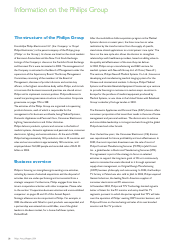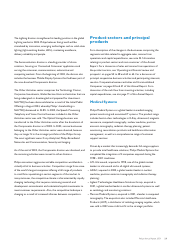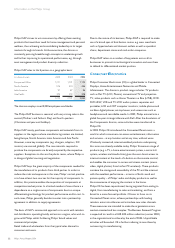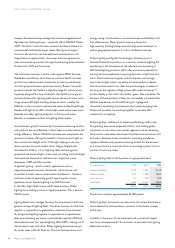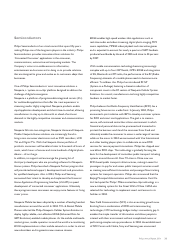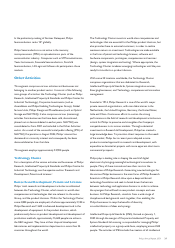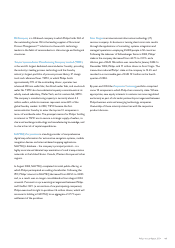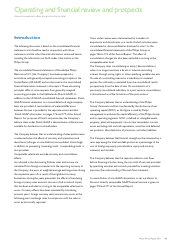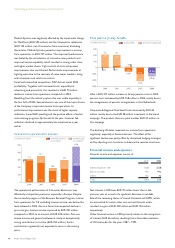Philips 2004 Annual Report Download - page 37
Download and view the complete annual report
Please find page 37 of the 2004 Philips annual report below. You can navigate through the pages in the report by either clicking on the pages listed below, or by using the keyword search tool below to find specific information within the annual report.
In November 2004, Philips, Nokia and RMV, the public transport
authority for Frankfurt’s greater area, announced a joint project to
trial an NFC ticketing solution that enables customers using the
Nokia 3220 mobile phone to access RMV’s bus transportation
services.
In the automotive sector, Philips has gained market share over the
last 10 years. One out of three cars sold worldwide uses Philips
car radio chipsets. One out of every five cars produced worldwide
has four ABS sensors from Philips. And one out of two cars
produced in Europe includes Philips RF Access & Immobilization.
In addition, Philips is active in various automotive consortia with
the aim of making vehicle performance more reliable and
therefore safer.
Philips’ strategic partnership with STMicroelectronics and
Freescale in Crolles, France, has delivered competitive advantages
in breakthrough technologies. The Crolles2 alliance has released a
90-nanometer CMOS process which will reduce power and
improve performance while cutting costs, accelerating the arrival
of new ‘connected consumer’ products and features. Philips is
world-class in the delivery of 90-nm technologies and ahead of the
field with the first chips to use 90-nm for low-power,
battery-operated applications.
As of January 1, 2003 some activities were transferred to
Semiconductors from the now-dissolved Components division.
The telecom speaker activity and Mobile Display Systems (MDS)
were moved to Philips Semiconductors, thereby offering
customers a single source for complete and integrated solutions
for the telecom and Personal Digital Assistant (PDA) sectors.
In 2004, MDS announced that it had passed a milestone with the
shipment of its one billionth display.
Semiconductors has significant investments in wafer-fabrication
ventures: approximately 48% in Systems on Sillicon Manufacturing
Company (SSMC) and an additional 6% via Taiwan Semiconductor
Manufacturing Company Limited (TSMC), approximately 19% in
TSMC, approximately 37% in ASMC and approximately 60% in
Jilin, China. In addition, Semiconductors has a 31% share in the
aforementioned plant in Crolles, France. The division currently has
20 manufacturing facilities throughout the world, located in
Europe, the United States and Asia.
In order to be more flexible and effective throughout the cyclical
industry movements it encounters, Philips Semiconductors has
adopted a capital-efficient manufacturing strategy. Furthermore, it
is focused on partnering with leading customers, content and
service providers to enable applications for the connected
consumer. Its portfolio incorporates emerging, mature and
multi-market products.
Philips Semiconductors sales to third parties on a geographic basis:
(in millions of euros) 2002 2003 2004
Europe and Africa 1,400 1,478 1,622
North America 795 576 503
Latin America 103 110 138
Asia Pacific 2,734 2,824 3,201
5,032 4,988 5,464
The division has approximately 35,100 employees.
Philips Semiconductors operates in an international market that
has shown enormous volatility, with annual growth rates varying
between + 37% and – 32% in the past five years (table hereafter:
source WSTS). In addition to the volatility, there have been
tremendous structural changes caused by the increasingly global
reach of major companies, mergers and acquisitions, and a move in
the industry to outsource manufacturing and design of a wide
range of electronic equipment. As a result of this, many of our
major customers now operate on a global basis.
1999 2000 2001 2002 2003 2004
(estimate)
Total available
market (billions
of USD) 149 204 139 141 166 213
Growth in % 19% 37% (32%) 1% 18% 27%
Semiconductor revenues can experience seasonal impact. In the
past, sales have increased in relation to high Christmas electronics
sales.
Philips Semiconductors’ products and solutions are supplied to the
large electronic equipment companies, whilst its standard products
are also sold via a number of global distributors. The division
delivers to more than 60 countries.
The first half of 2004 contrasted sharply with the fab
under-utilization and sluggish growth that characterized much of
the industry in 2003. Average utilization rates exceeded 90%
during 2004, but at year-end decreased to 81%. Having moved to a
more asset-light position in 2003, Philips Semiconductors has
further strengthened partnerships with external foundries,
allowing it to outsource a larger percentage of its capacity needs,
thereby achieving greater flexibility.
36 Philips Annual Report 2004
Information on the Philips Group




